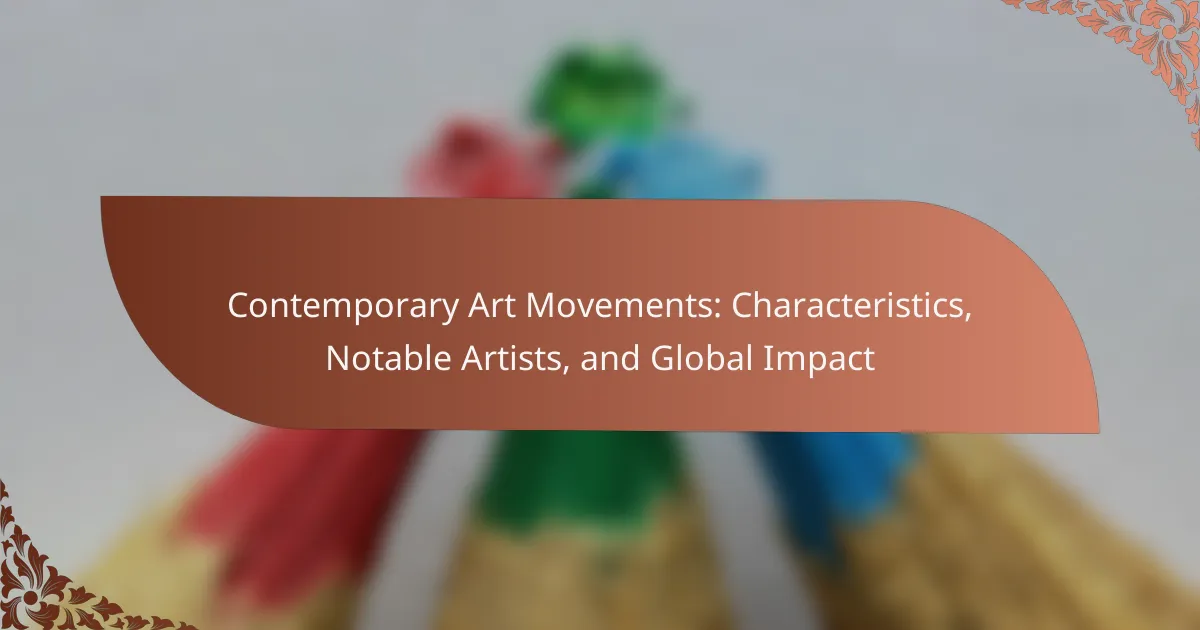Contemporary art movements shape our understanding of culture and society through innovation and social commentary. This article explores their defining characteristics, highlights notable artists like Banksy and Yayoi Kusama, and examines their global impact on public discourse. Discover how these movements challenge norms and provoke critical thinking in today’s world.
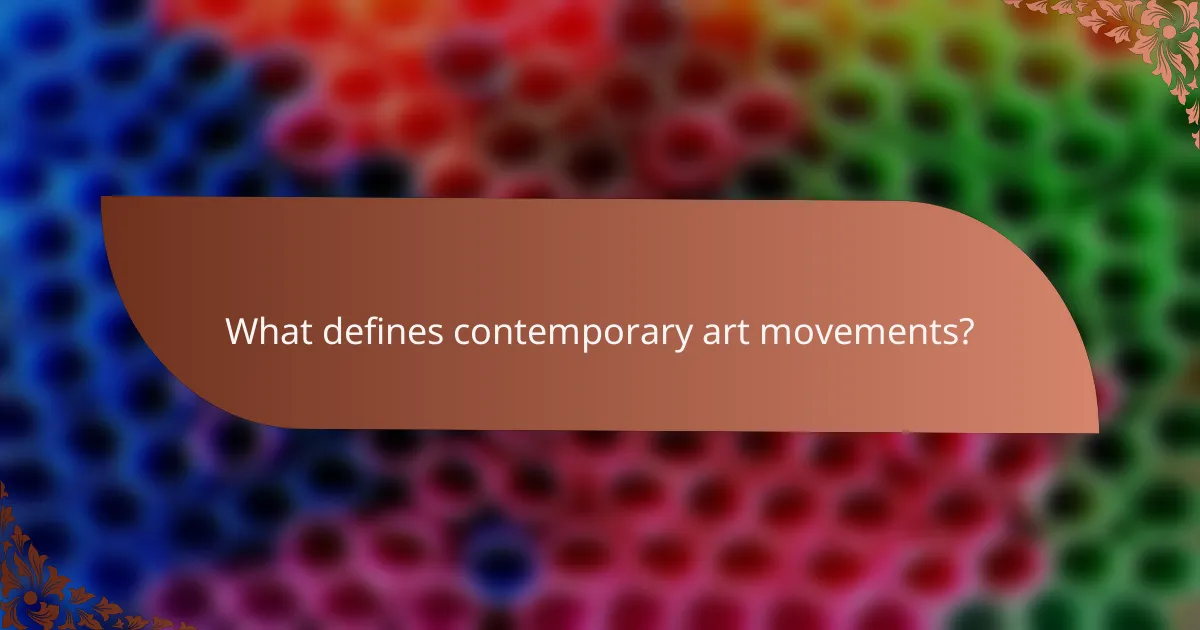
What defines contemporary art movements?
Contemporary art movements are defined by their diversity, innovation, and response to social issues. They often challenge traditional boundaries and embrace new technologies. Notable artists like Banksy and Yayoi Kusama exemplify these characteristics, influencing global culture. These movements have a significant impact on society, provoking dialogue and reflection on contemporary life.
How do cultural contexts shape contemporary art?
Cultural contexts significantly influence contemporary art by shaping themes, techniques, and artist perspectives. Artists often draw inspiration from their cultural backgrounds, reflecting societal issues and values. For instance, movements like Afrocentrism and Indigenous art emphasize cultural identity and heritage, challenging mainstream narratives. Globalization further impacts contemporary art, fostering cross-cultural exchanges that enrich artistic expression. As a result, contemporary art becomes a dialogue between diverse cultures, highlighting unique attributes while addressing universal themes.
What are the key characteristics of contemporary art?
Contemporary art is characterized by diversity, experimentation, and a focus on social and political themes. Key characteristics include the use of mixed media, incorporation of technology, and an emphasis on the viewer’s experience. Notable artists such as Damien Hirst and Yayoi Kusama exemplify these traits through innovative works that challenge traditional boundaries. The global impact of contemporary art is profound, influencing cultural conversations and inspiring movements across various regions.
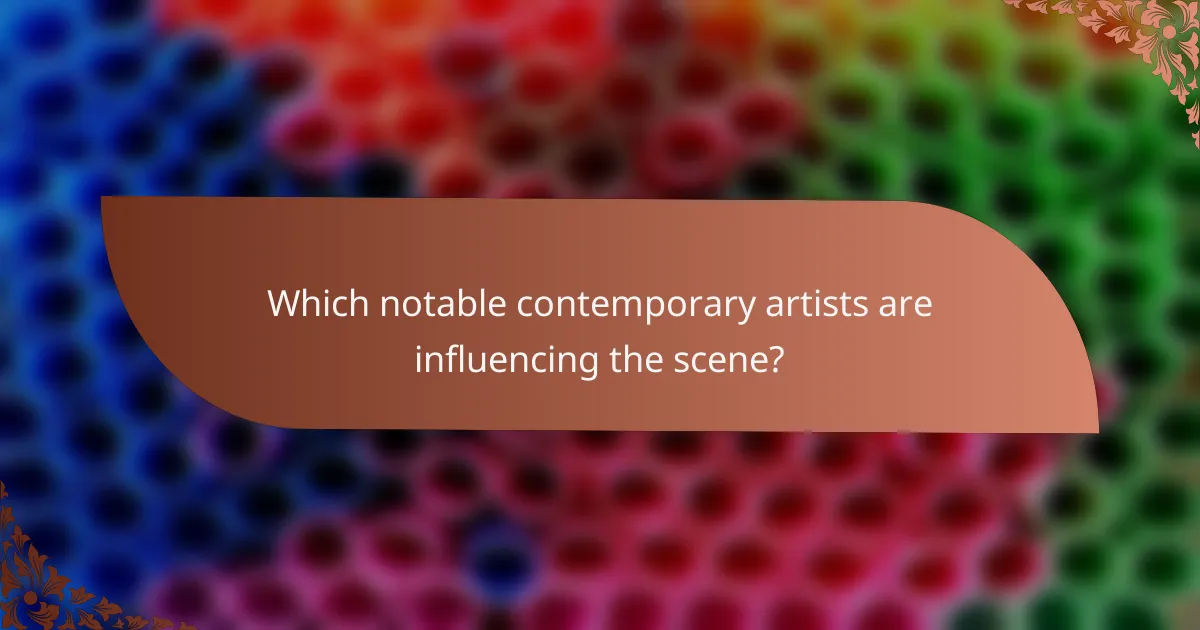
Which notable contemporary artists are influencing the scene?
Notable contemporary artists influencing the scene include Ai Weiwei, Yayoi Kusama, and Banksy. These artists shape contemporary art through innovative techniques and social commentary. Ai Weiwei addresses human rights issues, while Yayoi Kusama explores themes of infinity with her immersive installations. Banksy’s street art critiques societal norms and politics, engaging a global audience. Their distinct styles and thematic focuses exemplify the diverse landscape of contemporary art today.
What themes are prevalent in the works of leading contemporary artists?
Leading contemporary artists often explore themes such as identity, globalization, and environmentalism. These themes reflect societal issues and personal narratives, fostering dialogue and engagement. Notable artists like Ai Weiwei and Yayoi Kusama exemplify these themes through their unique approaches and mediums. Their work often challenges traditional boundaries, inviting viewers to reflect on contemporary realities.
How do regional differences manifest in the works of contemporary artists?
Regional differences manifest in contemporary art through diverse cultural influences, techniques, and themes. Artists often reflect their geographical backgrounds, incorporating local traditions and societal issues. For instance, African artists frequently address post-colonial narratives, while Asian artists may explore modernity versus tradition.
Notable artists like Ai Weiwei from China use their work to critique political systems, showcasing unique attributes tied to their locations. In contrast, Latin American artists often draw from vibrant cultural histories, blending contemporary practices with indigenous elements.
The global impact of these regional expressions fosters a rich dialogue within the art world, allowing for varied interpretations and appreciation. As a result, contemporary art becomes a dynamic platform for exploring identity, heritage, and social commentary across different regions.
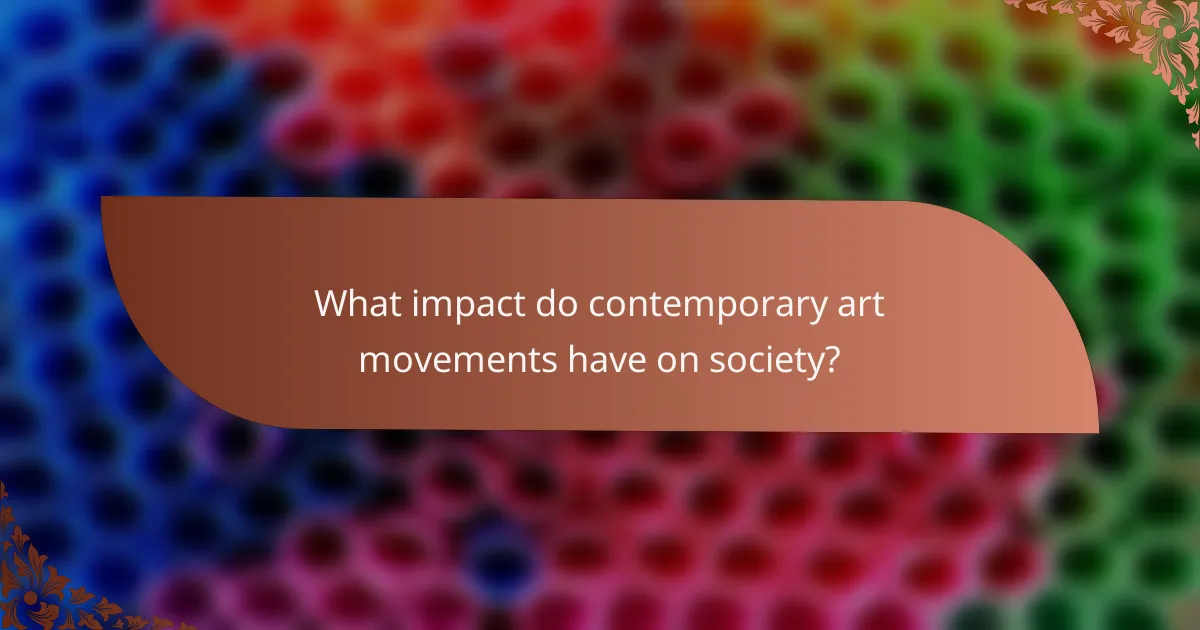
What impact do contemporary art movements have on society?
Contemporary art movements significantly influence society by challenging norms and provoking dialogue. They foster critical thinking, inspire social change, and reflect cultural shifts. Artists like Banksy and Ai Weiwei use their work to address political issues, raising awareness and encouraging activism. These movements often serve as a mirror, reflecting societal values and tensions, thus shaping public perception and discourse.
How does contemporary art influence public discourse and social change?
Contemporary art significantly shapes public discourse and drives social change through provocative themes and community engagement. Artists address pressing issues like inequality, identity, and climate change, prompting dialogue and reflection. Notable movements, such as street art and conceptual art, challenge traditional narratives and empower marginalized voices. This influence fosters awareness and activism, encouraging audiences to participate in social movements.
In what ways do contemporary art movements affect local economies?
Contemporary art movements significantly enhance local economies through tourism, job creation, and increased property values. Art festivals and galleries attract visitors, boosting local businesses. For instance, cities hosting major art events often see a rise in hotel bookings and restaurant patronage. Additionally, the presence of artists and galleries can drive up real estate prices, benefiting property owners. Overall, the influence of contemporary art movements fosters economic growth and cultural development in communities.
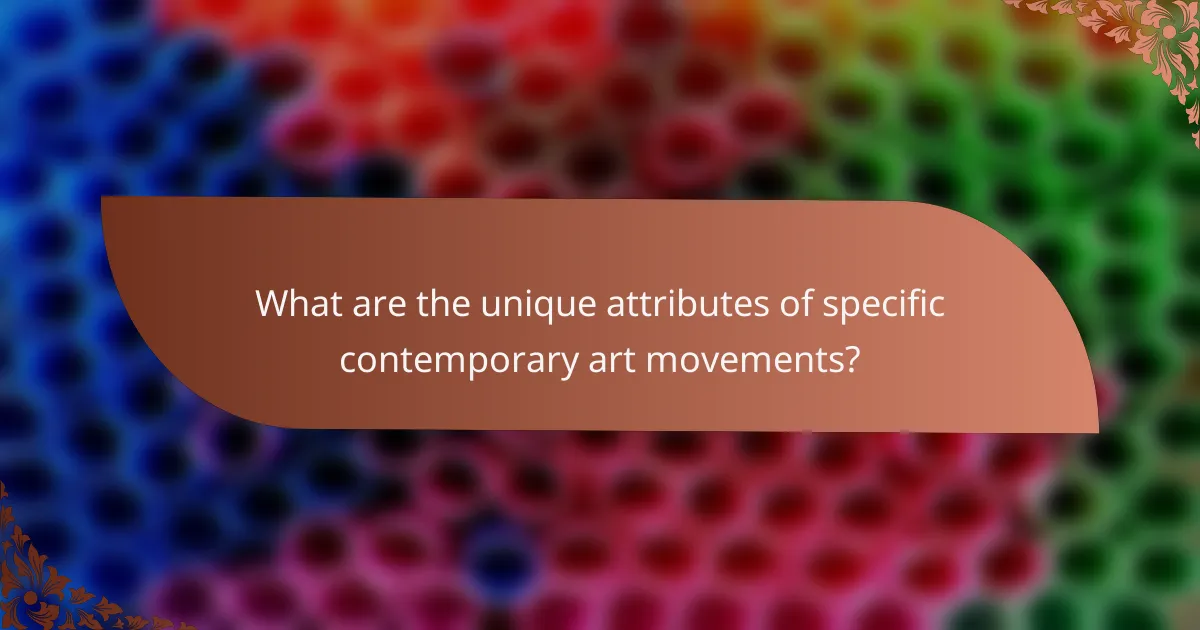
What are the unique attributes of specific contemporary art movements?
Contemporary art movements exhibit unique attributes that distinguish them from previous styles. These include a focus on social and political commentary, an embrace of diverse media, and an emphasis on viewer interaction.
Notable movements like Abstract Expressionism highlight emotional expression through abstraction, while Pop Art incorporates popular culture into artistic dialogue. Street Art often challenges traditional notions of art by utilizing urban spaces as canvases.
Additionally, movements such as Minimalism prioritize simplicity and form, demonstrating a unique attribute of reducing art to its essential elements. Each movement reflects distinct cultural contexts and influences, showcasing the evolving landscape of contemporary art.
How do movements like Street Art and Installation Art differ from traditional forms?
Contemporary art movements like Street Art and Installation Art emphasize interaction and public engagement, differing from traditional forms that focus on gallery spaces and individual viewing. Street Art often uses urban environments as canvases, challenging societal norms, while Installation Art transforms spaces to create immersive experiences. Notable artists like Banksy and Yayoi Kusama exemplify these movements, showcasing their global impact on cultural discourse.
What role does technology play in contemporary art practices?
Technology significantly enhances contemporary art practices by facilitating new forms of expression and interaction. Digital tools enable artists to create immersive installations, utilize virtual reality, and engage audiences through social media platforms. Notable artists like Rafael Lozano-Hemmer and Jenny Holzer leverage technology to explore themes of identity and communication. As a result, technology not only transforms the creative process but also broadens the accessibility and impact of art globally.
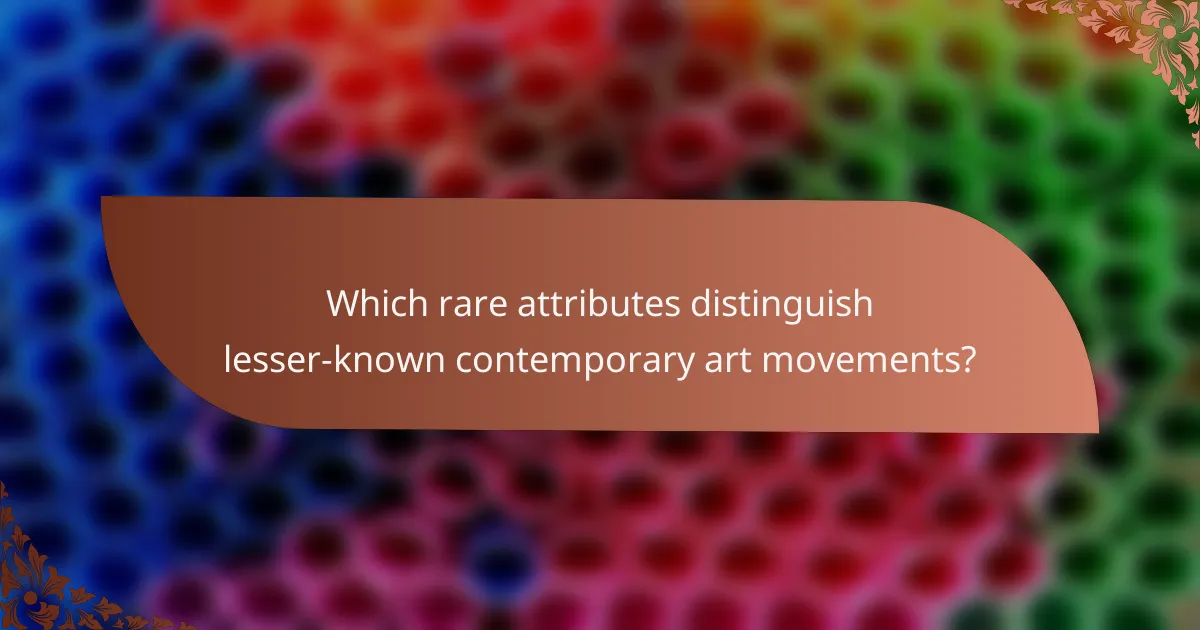
Which rare attributes distinguish lesser-known contemporary art movements?
Lesser-known contemporary art movements are distinguished by unique attributes such as their focus on social activism, integration of technology, and unconventional materials. These movements often challenge traditional art forms and promote participatory experiences. For example, movements like relational aesthetics emphasize audience interaction, while eco-art highlights environmental issues. The rarity of these attributes contributes to their distinctiveness within the broader contemporary art landscape.
What are the unique challenges faced by emerging contemporary artists?
Emerging contemporary artists face unique challenges such as market saturation, funding difficulties, and the pressure to conform to trends. They often struggle with visibility in a crowded space and securing representation. Additionally, navigating digital platforms for promotion can be overwhelming, especially with constant algorithm changes. The need for networking and building a personal brand adds further complexity to their careers.
How do experimental and avant-garde movements push boundaries in art?
Experimental and avant-garde movements push boundaries in art by challenging traditional norms and exploring new mediums. These movements encourage artists to innovate, resulting in unique expressions that often provoke thought and dialogue. Notable examples include Dadaism, which rejected conventional aesthetics, and Surrealism, which tapped into the unconscious mind. Such movements have significantly influenced contemporary art, leading to a global impact that embraces diversity and experimentation. Their legacy continues to inspire artists to explore uncharted territories in creative expression.
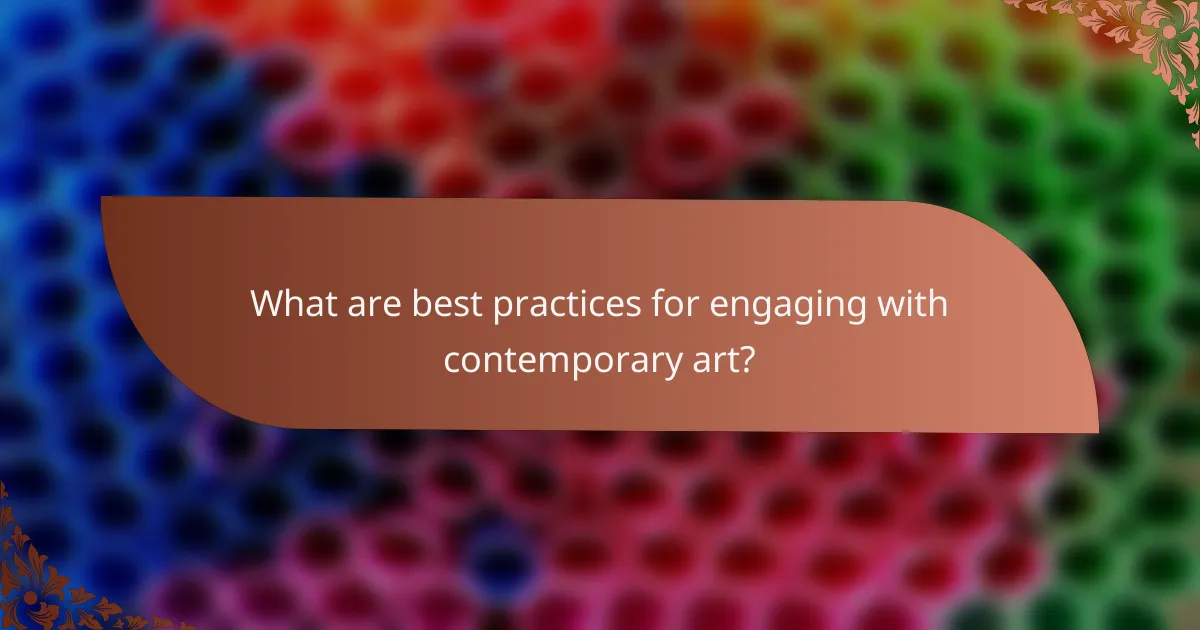
What are best practices for engaging with contemporary art?
Engaging with contemporary art requires an open mind and active participation. Attend exhibitions, interact with artists, and join discussions to deepen your understanding.
1. Visit diverse galleries to experience various movements.
2. Attend artist talks and panel discussions for insights.
3. Participate in workshops to explore creative processes.
4. Follow contemporary artists on social media for updates.
5. Join art communities to share perspectives and ideas.
6. Read art critiques and literature to enhance knowledge.
These practices foster a deeper appreciation and connection to contemporary art movements.
How can audiences effectively interpret contemporary art?
Audiences can effectively interpret contemporary art by engaging with its diverse characteristics and understanding the intent behind each piece. Recognizing the context of contemporary art movements, such as minimalism or conceptual art, is essential. Notable artists like Damien Hirst or Yayoi Kusama often challenge traditional aesthetics, prompting viewers to consider deeper meanings. Engaging with the global impact of these movements, including social or political commentary, enhances interpretation. Exploring personal emotions and perspectives also contributes to a richer understanding of contemporary art.
What common mistakes should viewers avoid when exploring contemporary art?
Viewers should avoid preconceived notions and overly critical judgments when exploring contemporary art. Engaging with the art without bias allows for a deeper appreciation of the diverse movements and the intentions behind the works.
Common mistakes include ignoring the context of the artwork, which can significantly influence its meaning. For example, understanding the socio-political environment during an artist’s career can provide insight into their creations.
Another mistake is focusing solely on technical skill rather than the concept or message behind the piece. Contemporary art often prioritizes ideas over traditional techniques, which can lead to misunderstanding its value.
Lastly, viewers may overlook the importance of personal interpretation. Each individual’s response to contemporary art is valid and contributes to a richer dialogue about its impact and relevance.
